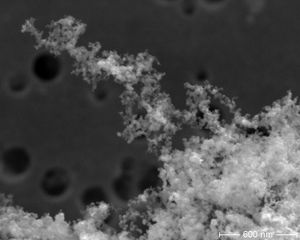KANBrief 3/19

Nanomaterials do not exhibit any particular new form of toxicity. The release of nano dusts may however lead to hazards at the workplace. A grouping approach supports the specification of effective protective measures. Particular attention must be paid to materials that release respirable, biopersistent fibrous particles in the course of their life cycle.
Extensive studies have failed to confirm the assumptions, voiced around 15 years ago, that nanomaterials are particularly toxic. Rather, the properties of nanomaterials making them hazardous to health at the workplace can be described by the conventional principles of substance and particle toxicology. An announcement (in german) by the German Committee for hazardous substances, BekGS 527, draws upon this approach in formulating a regulatory grouping concept. The concept was adopted in 2018 by the World Health Organization in evidence-based guidelines on nanomaterials and workers‘ health. The grouping approach, which can also be applied to other materials, draws a distinction between:
Comprehensive toxicological findings now exist for GBP substances that permit differentiation during the formulation of OSH measures. A general dust limit value (in german) of 1.25 mg/m³ applies to compact microscale particles with a density of 2.5 g/cm³3. For GBP nanomaterials, which generally release lighter, porous particle agglomerates, the AGS Committee for Hazardous Substances recommends a value of 0.5 mg/m³ as the assessment criterion for the efficacy of the OSH measures taken. This value can normally be reliably observed by means of the safety requirements set out in the German Ordinance on hazardous substances (GefStoffV) for particulate hazardous substances.
By contrast, materials that release respirable biopersistent fibrous dusts present a challenge for occupational safety and health. This can also be seen from the issue of asbestos, which has still not been resolved 25 years after the substance‘s ban in Germany. Toxicity as a function of inhaled material mass is up to several orders of magnitude greater than that of the GBP materials, and exhibits a wide spectrum as a function of the biopersistence. The rigidity of the inhaled fibres is also relevant: extremely thin fibres are more similar to GBPs in their properties. Extreme differences in the dust-forming properties of different materials are also a factor. A very wide spectrum of risk must therefore be taken into account during the formulation of protective measures. In a worst-case scenario (as in that of asbestos), this may also extend to legal restrictions upon use in certain areas.
In the case of materials with specific toxicity, the chemical composition is the chief factor determining the effect profile. Occupational exposure limits and protective measures can therefore be laid down in the same way as for known „parent materials“ of the same composition.
Material safety data sheets, which must be supplied with all hazardous substances and mixtures, must contain sufficient information for performance of the risk assessment. The test and information requirements for registration of the nanoforms of substances under the EU REACH (pdf) Chemical Regulation were recently extended, including by the addition of dust-formation tests. Gaps in regulation continue to exist however, particularly concerning fibrous forms of substances that do not fall under the definition of „nanoform“. KAN‘s strategy group on nanotechnology and occupational safety and health is examining what activities for the standardization of testing, measurement and assessment methods are required for further support of the statutory regulations. Another objective is for the different players in this area (in particular the OECD, CEN and ISO) to be networked more effectively, in order for them to coordinate their activities more closely. In addition to the BekGS 527 and the WHO guidance, the „Nano-to-go“ information package of the German Federal Institute for Occupational Safety and Health (BAuA) provides comprehensive support for research institutions and companies.
Dr Rolf Packroff
Scientific Director in Division 4, Hazardous substances and biological agents
packroff.rolf@baua.bund.de